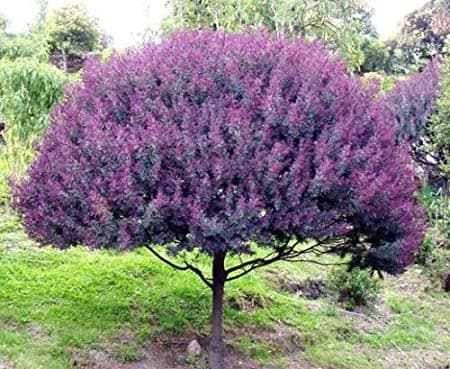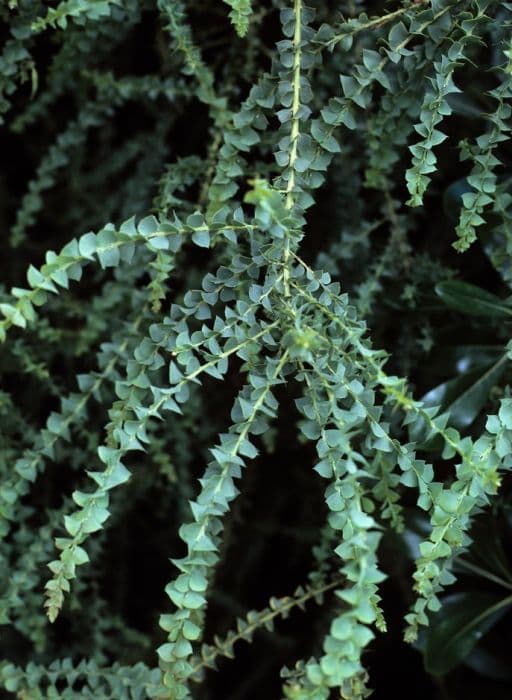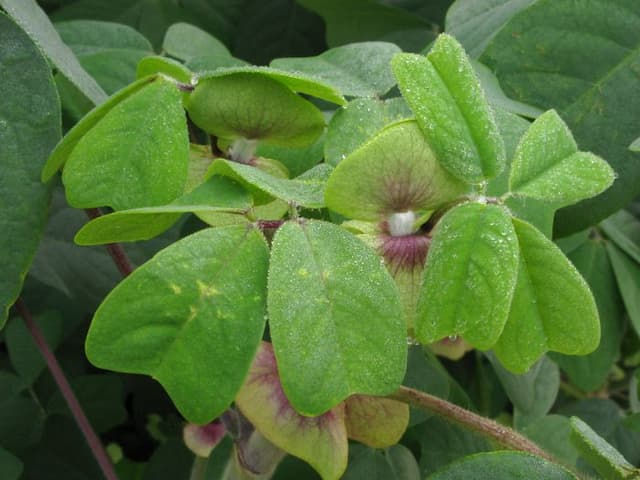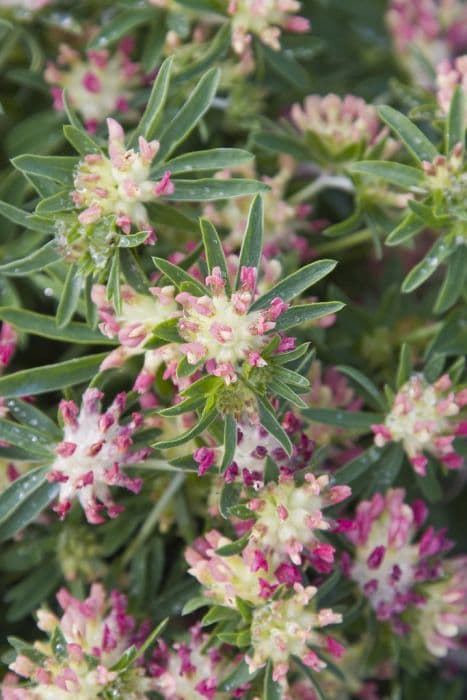White Broom Cytisus × praecox 'Albus'
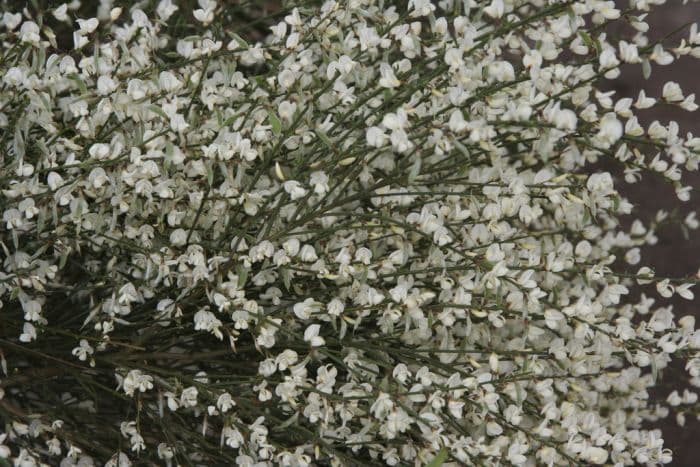
ABOUT
The Cytisus × praecox 'Albus', also commonly known as white broom or warminster broom, features a dense and bushy appearance. This deciduous shrub blooms prolifically in the spring, with an abundance of small, white, pea-like flowers that cluster together, creating a magnificent display against the green foliage. The leaves are small and trifoliate, meaning they come in groups of three. They are a bright green color, offering a striking contrast to the white blossoms. As the flowering season progresses, these leaves serve as a lush background for the less densely packed, yet still remarkable, white flowers that may continue to appear sporadically. The branches of the white broom are slender and have a slightly arching habit, contributing to the plant's overall rounded and fluffy shape. The texture of the branches is somewhat rough, with a bark that may become increasingly textured as the plant matures. Flower buds typically appear at the tips of the stem and may be slightly fuzzy before they fully open into the characteristic small, papilionaceous (butterfly-like) blossoms. After the blooming period, the flowers may be followed by small seed pods, which eventually dry and may crack open to release seeds. Overall, the white broom's appearance is characterized by its bright, showy flowers, its delicate green leaves, and its somewhat graceful, arching branches.
About this plant
 Names
NamesFamily
Fabaceae
Synonyms
Warminster Broom, White Warminster Broom
Common names
Cytisus × praecox 'Albus'.
 Toxicity
ToxicityTo humans
The Cytisus × praecox 'Albus', commonly known as Warminster broom, contains toxic alkaloids which can cause harm to humans if ingested. Symptoms of poisoning may include nausea, vomiting, and dizziness. In severe cases, ingestion can lead to respiratory failure and even death. Therefore, it is important to prevent ingestion of any part of this plant by humans, especially children.
To pets
Warminster broom is also toxic to pets due to the presence of alkaloids. If pets ingest parts of this plant, they can experience symptoms similar to those in humans, such as vomiting, diarrhea, and abdominal pain. In severe cases, it could lead to tremors, respiratory problems, and even death. Pet owners should ensure that their animals do not have access to or consume any part of the Warminster broom plant.
 Characteristics
CharacteristicsLife cycle
Perennials
Foliage type
Deciduous
Color of leaves
Green
Flower color
White
Height
5 feet (1.5 meters)
Spread
5 feet (1.5 meters)
Plant type
Shrub
Hardiness zones
6
Native area
Europe
Benefits
 General Benefits
General Benefits- Ornamental Value: Cytisus × praecox 'Albus', commonly known as White Broom, has showy white flowers that add aesthetic appeal to gardens and landscapes.
- Drought Tolerance: Once established, White Broom is quite drought-tolerant, making it suitable for xeric landscapes or areas with low water availability.
- Low Maintenance: It requires minimal care beyond initial planting and occasional pruning, which is ideal for low-maintenance gardens.
- Rapid Growth: This plant tends to grow rapidly, allowing for quick establishment and filling in of garden spaces.
- Erosion Control: The root system of White Broom helps stabilize the soil, preventing erosion on slopes and banks.
- Attracts Pollinators: The flowers are attractive to bees and other pollinating insects, which is beneficial for the garden ecosystem.
- Adaptability: It can adapt to a variety of soil types, though it prefers well-drained soils, making it versatile for different garden settings.
- Spring Interest: Blooming in early spring, White Broom provides color and interest after the winter season when few other plants are flowering.
 Medical Properties
Medical PropertiesThis plant is not used for medical purposes.
 Air-purifying Qualities
Air-purifying QualitiesThis plant is not specifically known for air purifying qualities.
 Other Uses
Other Uses- Cytisus × praecox 'Albus', or white broom, can be planted in gardens to stabilize soil and prevent erosion due to its root system that holds the ground effectively.
- In the art of bonsai, the white broom's distinctive growth pattern and small leaves can be cultivated to create miniature landscapes.
- Dried white broom branches can be used in floral arrangements for their interesting texture and form.
- The white broom's wood is hard and dense, making it suitable for crafting small wooden objects, such as handles and walking sticks.
- As a nitrogen-fixing plant, white broom can improve soil fertility in poor soils, making it useful in permaculture and regenerative agriculture practices.
- Dense white broom shrubs can act as a windbreak, helping to protect more delicate plants in the garden from harsh winds.
- The blossoms of the white broom can be used to produce natural dyes for textiles, yielding various shades of green and yellow.
- The shrub can be used as a training plant for students learning about pruning techniques, due to its vigorous growth habit and need for regular maintenance.
- White broom's ability to grow in coastal areas where other plants may struggle makes it a good candidate for landscaping in such challenging climates.
- Its dense foliage and rapid growth can provide a quick-growing screen for privacy or to mask unsightly views in a garden setting.
Interesting Facts
 Feng Shui
Feng ShuiThe Warminster broom is not used in Feng Shui practice.
 Zodiac Sign Compitability
Zodiac Sign CompitabilityThe Warminster broom is not used in astrology practice.
 Plant Symbolism
Plant Symbolism- Cleansing: Cytisus, commonly known as Broom, particularly in its historical use, was employed to craft brooms for physical cleaning, thus symbolizing spiritual and emotional purification.
- Humility: Broom plants often grow in poor soils and are unpretentious, hardy plants, representing the virtue of humility and the ability to thrive in challenging conditions.
- New Beginnings: The plant's vigorous growth and abundant flowering can represent fresh starts or new ventures, aligning with its blooming in spring, a natural time for renewal.
- Protection: Folklore suggests that Broom was believed to ward off evil spirits and witches, thus it is a symbol of guarding against negative forces.
- Vitality: Broom's robust nature and bright flowers are symbolic of energy and the dynamic force of life.
 Water
WaterThe White Broom should be watered regularly during its growing season in spring and summer, ensuring the soil is moist but not waterlogged. Typically, watering once a week with 1 to 1.5 gallons of water should suffice, but this can vary depending on climate conditions and soil drainage. During winter, reduce watering to every two to three weeks, providing just enough water to prevent the soil from drying out completely. It's crucial to avoid overwatering as this can lead to root rot.
 Light
LightThe White Broom thrives best in full sun, so position it in a spot where it receives at least six hours of direct sunlight daily. Avoid places that are shaded for most of the day, as insufficient light can affect its blooming and overall growth.
 Temperature
TemperatureThe White Broom is hardy and can tolerate a range of temperatures, but it performs best when the temperature is between 50 and 75 degrees Fahrenheit. It can survive minimum winter temperatures down to about 20 degrees Fahrenheit, but exposure to severe frost should be avoided. Ideal growing conditions involve moderate temperatures without extreme heat or cold.
 Pruning
PruningThe White Broom should be pruned immediately after flowering to maintain its shape and encourage bushier growth. Pruning is typically done in late spring or early summer. Cut back flowering stems by about half, taking care not to cut into old wood, as this may not regrow. Annual pruning helps rejuvenate the plant and prompts more profuse blooming in the following season.
 Cleaning
CleaningAs needed
 Soil
SoilThe Warminster Broom (Cytisus × praecox 'Albus') thrives in well-draining soil with a slightly acidic to neutral pH of 6.0 to 7.5. A mix of garden soil, peat, and coarse sand is ideal, which ensures proper drainage while retaining enough moisture.
 Repotting
RepottingWarminster Broom requires minimal repotting, usually only when it outgrows its container. This may not be frequent, as it is typically grown outdoors and has a relatively slow growth rate.
 Humidity & Misting
Humidity & MistingWarminster Broom is quite tolerant of different humidity levels but prefers moderate humidity. Excessively high humidity can lead to fungal issues, whereas too low might cause desiccation.
 Suitable locations
Suitable locationsIndoor
Not ideal for indoor growth; needs full sun, infrequent watering.
Outdoor
Plant in full sun, well-draining soil; tolerates drought once established.
Hardiness zone
6-8 USDA.
 Life cycle
Life cycleThe Cytisus × praecox 'Albus', commonly known as white broom, begins its life cycle with germination, where its seeds sprout in well-drained soil with full to partial sunlight exposure. Upon sprouting, the seedling stage is marked by the emergence of the first set of true leaves after the initial seed leaves. The vegetative stage follows, with the plant rapidly growing stems and foliage, establishing a robust root system. As it matures, the white broom enters the flowering stage, typically in the spring, showcasing white, pea-like flowers that attract pollinators. After pollination, the flower gives way to seed pods, which mature, dry out, and release seeds for dispersal, completing the reproductive cycle. Finally, after several years, the plant may reach the end of its lifespan, which can be prolonged through proper pruning and care to maintain its vitality and blooming capacity.
 Propogation
PropogationPropogation time
Spring to Early Summer
The most popular method of propagation for the Warminster Broom, scientifically known as Cytisus × praecox 'Albus', is through semi-hardwood cuttings. This process typically takes place in late summer. Cuttings about 6 inches (approximately 15 centimeters) long are taken from the current year’s growth. The lower leaves are removed, and the cut end of the cutting can be dipped in rooting hormone to enhance root development. These cuttings are then placed in a well-draining rooting medium such as a mix of peat and perlite. The environment should be kept humid, often by covering the cuttings with a plastic bag or placing them in a propagator, and they are kept out of direct sunlight until roots have developed, which usually takes a few weeks.
